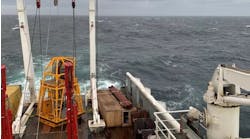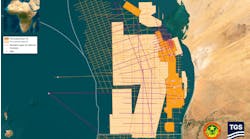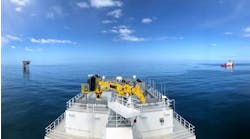Offshore staff
SAN ANTONIO –Schlumberger released its Play-to-Prospect Risk plug-in for Petrel today at the Society of Exploration Geophysicists Annual Meeting.
The plug-in integrates petroleum-system-based assessment for consistent evaluation of key risks from play to prospect, said Schlumberger.
The Play-to-Prospect Risk plug-in takes geological elements—trap, reservoir, charge, and seal—and converts them into chance maps through a suite of transform methods. Scenarios are compared to determine play limits and to identify areas for high grading to rapid ranking of opportunities. The process seamlessly migrates from play-scale to prospect-level assessment, all within Petrel. This enables refinement of geological scenarios combined with chance of success—to deliver probabilistic hydrocarbon volumes.
Consistent workflows for play-to-prospect risk assessment across teams provide a standard method to evaluate study areas with a clear audit trail. The plug-in calculates the mean economic case for potential field development and the probabilistic economic resource case—based on the minimum economic reserve parameter for the geographic area.
Within the overall program are several specific items that add functionality, said Schlumberger. For instance, the play-scale mapping can overlay all the available maps while keeping them linked to the original data. This same data linking also means the system can integrate prospects and conduct relevant scenarios.
Beyond that, the program does not accept geologically implausible numbers, said Schlumberger. It also can go back into Petrel to see which parameter of the prospect is the most critical to overall success.
“While seismic technology advances have enabled better evaluation of trap and reservoir risks, almost three-quarters of dry exploration wells are due to an inadequate understanding of charge and seal risk,” said Tony Bowman, president, Schlumberger Information Solutions (SIS). “With the new Play-to-Prospect Risk plug-in, oil and gas companies have a standardized process that integrates petroleum-system-based assessment to better understand charge and seal risk.”
Complementing the exploration capabilities of the Play-to-Prospect Risk plug-in, the new Prestack Seismic Interpretation plug-in brings the technology to the Petrel platform to further refine understanding of petroleum system elements including charge, risk, and trap definition. Geoscientists can analyze prestack gathers to better understand processing effects on post-stack data; evaluate response differences in offset traces to evaluate fluid effects; make on-the-fly offset stacks to create clearer partial stacks of interpretation targets; as well as interpreting and auto-tracking directly on pre-stack data for better horizon definition.
09/20/2011


